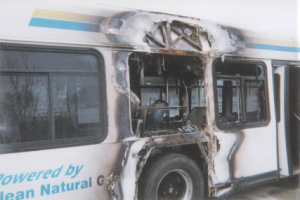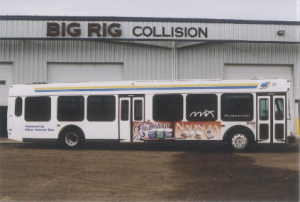
By David Hubbard
In the mop up after an accident, one final item on the list is to tend to the damaged coach. The question is often whether to repair or replace, with several mitigating scenarios in play where there is no one answer. The first step is to simply do the math.
the mop up after an accident, one final item on the list is to tend to the damaged coach. The question is often whether to repair or replace, with several mitigating scenarios in play where there is no one answer. The first step is to simply do the math.
Before the accident the coach carried a cash value that becomes the base to measure the severity of damage afterward. The day after the accident the operator could be looking at a repair cost of $100,000 on a coach valued at $200,000.
The insurance company considers both the pre-accident value and age of the vehicle; measures it against the repair estimate; and may decide to just write it off where the margin is close. The operator may even prefer to take the cash and apply it to operating expenses.
Get more great articles like this one with a subscription to BusRide!
Click here to subscribe.
In another scenario, the damage to a $200,000 coach may cost $105,000 to repair. The operator accepts the cash to send it to the collision repair company, but instead parks it on the lot and runs another coach in its place, again using the money to keep afloat when business is down.
In this case the trouble begins when business improves and the company needs all its coaches. Now the operator is faced with scraping together the $100,000 to make the repairs.
The owner also may receive a salvage bid for what someone is willing to pay for the vehicle in its heavily damaged state. Say that bid is $100,000, which with the repair costs, equals the pre-accident value and the insurance company writes it off. A more realistic, a salvage bid might be $20,000. Added to the repair bill there is a gap of $80,000 between what the insurance company has to pay the owner and what it can recover by way of salvage and the estimate, meaning the coach would go to the repair shop.
Financial considerations
“The closer that gap becomes, the more likely of a write off,” says Brad Field, president of BRC Coach and Transit, formerly Big Rig Collision, Calgary, AB, Canada. “The financial considerations seem to always come first.”
Then there is downtime, which is always costs one way or another. Even if the insurance company is paying a stipend, the time a coach is out of service is costly, considering the potential revenue for coach carrying 53 passengers at $75 a seat amounts to nearly $4,000.
Fields says the time out of service figures more prominently for an owner losing money directly as the result of the damage; where having a replacement coach is not an option.
“The objective is to create the least possible interruption in revenue stream,” he says. “The decision to repair or replace may hinge on which option is the fastest.”
 Choosing an experienced and knowledgeable collision repair shop is paramount. Fields warns that while many companies claim to provide bus and coach collision repair services, only about six throughout North America truly have the expertise and equipment to complete a full-scale repair in a short turnaround time.
Choosing an experienced and knowledgeable collision repair shop is paramount. Fields warns that while many companies claim to provide bus and coach collision repair services, only about six throughout North America truly have the expertise and equipment to complete a full-scale repair in a short turnaround time.
Push for the write off
“Much of the time consideration has to do with availability of parts and the costs associated with waiting for the order to arrive,” says Field. “It becomes a dilemma. The owner who cannot afford to have the coach out of service may push for the write off and start looking at a pre-owned replacement.”
He says inexperience in knowing all the parts to be order can create delays. BRC Coach and Transit favors the fully equipped one-stop shop as opposed to collision companies that may have to farm out much of the work.
“They can add to the delay,” says Field. “But more importantly, the contract shop loses control on the quality of work.”
As an example of turnaround time, BRC Coach and Transit is presently repairing a damaged vehicle for an eastern city transit agency.
“This bus has been out of service for 13 months,” says Rob Peck, BRC vice president, business development. “We expect a 3 month turn around on this particular collision repair, including the time to transport the bus to Calgary and back.”
Fields says there is not much the best collision repair shop cannot do, especially on coaches with pre-accident values of over $500,000.
“It would take an absolute catastrophic event for us to call it a write-off,” he says.”Time and money aside, when it comes to the actual physical damage, a top-notch collision repair shop can rebuild and refurbish just about any heavy collision.”
BRC Coach and Transit claims its all-time record single repair bill of $362,000 on a coach valued at $550,000.
Save time and money
The key, says Field, is to save time and money for both the owner and the insurance company, and still deliver as good if not better final product in the shortest amount of time possible, which includes the knowledge and resources to obtain the required parts.
Do you like this article? Subscribe TODAY to get
BusRide now available in digital!
“All too often, an estimate will come in at $60,000 with the promise of a 3-month turnaround,” says Peck. “By the time the job is complete, eight months may have passed and the shop may have submitted another $30,000 worth of supplements to the operator or insurance company.”
